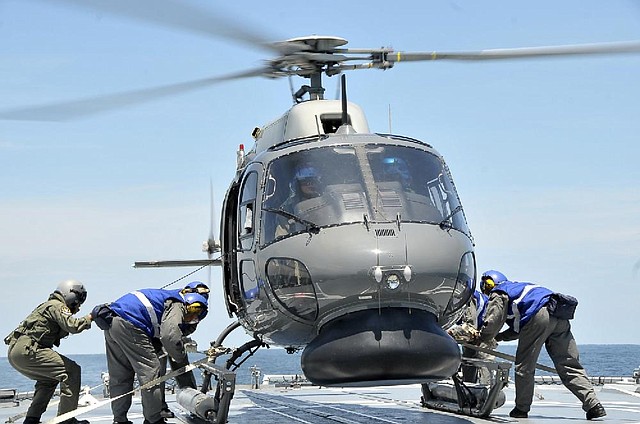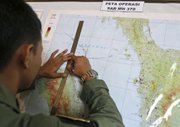Hunt for jet widens toward India
Led by satellite images, searchers find nothing off Vietnam
A military helicopter prepares to lift off Thursday to aid in the search for the missing jetliner over the Straits of Malacca, Malaysia, in this photo released by the Royal Malaysian Navy.
Friday, March 14, 2014
KUALA LUMPUR, Malaysia - Malaysian authorities expanded their search for a missing jetliner westward toward India on Thursday, saying it may have flown for several hours after its last contact with the ground.
That scenario would make finding the Boeing 777 a vastly more difficult task and raises the possibility that searchers have been looking in the wrong place for the plane and its 239 passengers and crew since it disappeared early Saturday en route to Beijing.
Also Thursday, planes were sent to search an area off the southern tip of Vietnam where Chinese satellite images published on a Chinese government website reportedly showed three suspected floating objects.
“There is nothing. We went there, there is nothing,” said acting Malaysian Transport Minister Hishammuddin Hussein.
Compounding the frustration, he later said the Chinese Embassy had notified the government that the images were released by mistake and did not show any debris from Malaysia Airlines Flight 370.
The plane left Kuala Lumpur and was flying northeast across the Gulf of Thailand and into the South China Sea when it dropped off civilian radar without any indication it was having any technical problems.
An international search effort is methodically sweeping parts of the South China Sea. A roughly similar-size hunt also is being conducted to the west in the Strait of Malacca because of military radar sightings that might indicate the plane headed that way after its last contact, passing over the Malay Peninsula. The total search area is about 35,800 square miles, or about the size of Portugal.
A U.S. official, who spoke on condition of anonymity because he wasn’t authorized to discuss the situation by name, said Thursday that the Malaysia Airlines plane sent signals to a satellite for four hours after the aircraft disappeared, an indication that it was still flying for hundreds of miles or more
The official said the Boeing 777-200 wasn’t transmitting data to the satellite but was sending out a signal to establish contact.
Boeing offers a satellite service that can receive a stream of data during flight on how the aircraft is functioning and relay the information to the plane’s home base.Malaysia Airlines didn’t subscribe to that service, but the plane still had the capability to connect with the satellite and was automatically sending pings, the official said.
“It’s like when your cellphone is off, but it still sends out a little ‘I’m here’ message to the cellphone network,” the official said. “That’s how sometimes they can triangulate your position even though you’re not calling because the phone every so often sends out a little bleep. That’s sort of what this thing was doing.”
Boeing did not comment on the official’s statement.
Asked if it were possible that the plane kept flying for several hours, Hishammuddin said: “Of course, we can’t rule anything out. This is why we have extended the search. We are expanding our search into the Andaman Sea.”
The sea, part of the Indian Ocean, is northwest of the Malay Peninsula.
He said Malaysian authorities were asking for radar data from India and other neighboring countries to see if they can trace the plane flying northwest. India plans to imminently deploy airplanes and ships in the southern section of the sea, a senior Indian official said on condition of anonymity because he was not authorized to speak to the media.
More than two-thirds of those on board the plane were from China, which has shown impatience with the absence of any results. Chinese Premier Li Keqiang said Thursday in Beijing that it he would like to see better coordination among countries involved in the search.
The passengers’ “families and friends are burning with anxiety, the Chinese government and Chinese people are all deeply concerned about their safety,” he said at the close of the annual session of the country’s legislature. “As long as there is a glimmer of hope, we will not stop searching for the plane.”
He said China had deployed eight ships and was using 10 satellites to search for the plane.
Malaysia’s air force chief said Wednesday that an unidentified object appeared on military radar records about 200 miles northwest of Penang, Malaysia, and experts are analyzing the data to determine whether the blip was the missing plane.
Malaysia has received some criticism for its handling of the search, in part because it took several days to fully explain why it couldn’t say for sure whether the plane had turned back.
Officials said they are not hiding anything and are searching areas where the plane is most likely to be, while attempting to establish its actual location.
“There is no real precedent for a situation like this. The plane just vanished,” Hishammuddin said.
Experts said that if the plane crashed into the ocean, then some debris should be floating on the surface even if most of the jet is submerged. Past experience shows that finding the wreckage can take weeks or even longer, especially if the location of the plane is in doubt.
Information for this article was contributed by Joan Lowy and Josh Lederman of The Associated Press.
Front Section, Pages 6 on 03/14/2014


